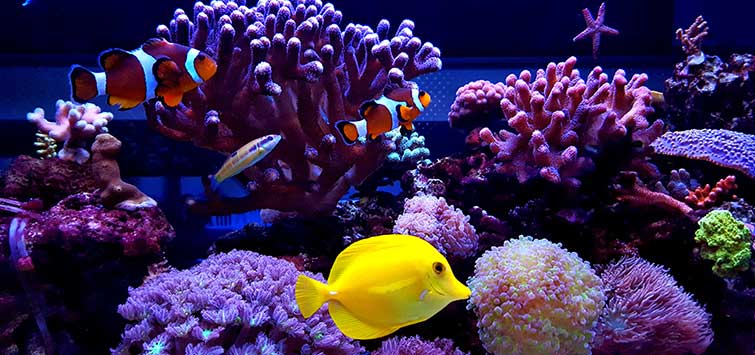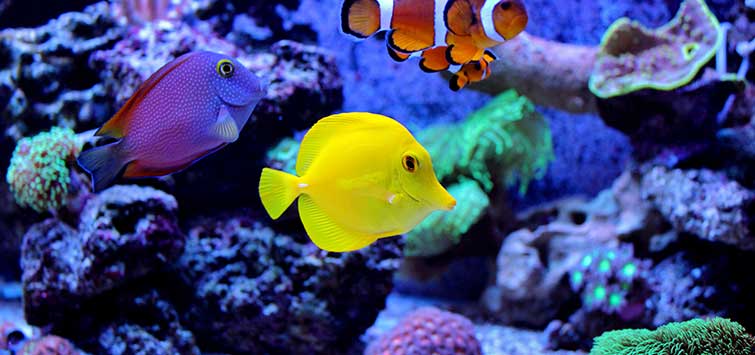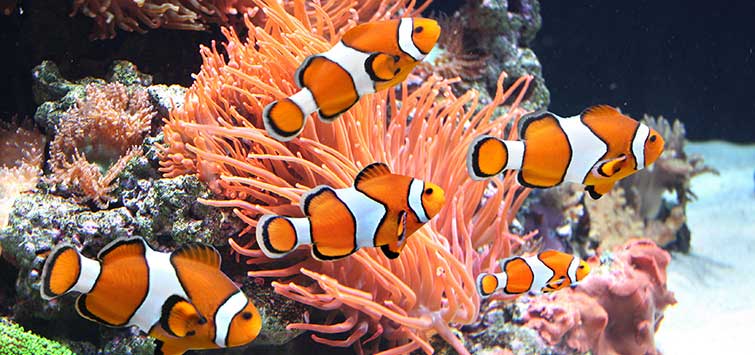Salinity Measurements for Marine Aquariums
Author: Jay Hemdal
Aquarists may not always strive for exact results during a typical measurement for specific gravity, but there are certain instances that do require more precision. A noted marine aquarium expert elaborates on methods, measurements, and the equipment utilized to achieve accurate salinity readings.
Managing Salinity
The fundamental difference between freshwater and marine aquariums is their respective salt content. The salt level is usually reported as either salinity (parts per thousand [ppT] of salt in water) or specific gravity (the density of the solution relative to fresh water).
Measuring the specific gravity of an aquarium is one of the first tasks learned by new marine aquarists. Obtaining an approximate specific gravity of an aquarium is as simple as dipping up a water sample into a specific gravity meter and reading the number across from the pointer. There are instances, however (such as hyposalinity fish treatments and reef aquariums), where more accurate measurements may be required. In this article I hope to offer some tips for more accurately measuring and managing the salinity of your aquarium’s water. (Beginning aquarists may find it helpful to jump ahead to the glossary in order to familiarize themselves with some of the technical terms involved.)
Glass Hydrometers
A glass hydrometer is a long glass tube that has a narrow neck with a scale on it. When floated in a liquid, it rises proportionally higher the denser the solution is. In most cases, it is best to fill a tall cylinder with the water to be tested, and immerse the hydrometer in the cylinder rather than floating it free in the aquarium. The hydrometer reading is taken by determining where the water level intersects the scale on the stem.
Reading the Waterline
Remember to take the reading at the actual waterline, at the bottom of the meniscus (the concave surface of the water whose edge bends up the side of the narrow stem due to surface adhesion). To do this, take the reading from slightly below the water level, looking upward toward the stem of the hydrometer. Two issues can change the precision of a glass hydrometer: tiny bubbles that adhere to the tube can lift the hydrometer higher, giving a false high reading, or the tube may stick to some adjacent surface, which tends to hold the hydrometer lower in the water, resulting in a falsely low reading.
Measuring Gravity
For early aquarists, the floating glass hydrometer was usually the only device available to measure the specific gravity of their marine aquariums. Over the past 25 years, these small glass hydrometers have almost been entirely replaced by the more convenient dip-and-read plastic hydrometers. Laboratory-grade hydrometers are still perhaps the best reference (on the basis of cost versus ease of use) for confirming the accuracy of another type of specific gravity meter.
While small glass hydrometers are precise between .001 and .0005 specific gravity units, a high-quality glass hydrometer can have a precision of .0001 specific gravity units, higher than any other device routinely available for a home aquarist.
Dip-and-Read Hydrometers
Dip-and-read plastic hydrometers (or specific gravity meters) have become almost ubiquitous in their use by marine aquarists. Although generally reliable and certainly less prone to breakage than glass hydrometers, these units can lose their accuracy over time, or may even be inaccurate when first purchased. Standardization is problematic because of the difficulty in locating an accurate reference source to compare them against.
With plastic hydrometers, it is known that new units have a propensity to give false high specific gravity readings due to minute air bubbles that can attach to the pointer. Over time, the surface tension of the plastic pointer seems to become reduced, and bubbles are less of a problem. Older units are suspected of reading lower due to mineral buildup at the pivot point, or even a change in density in the plastic that composes the swing arm.
Reading the Waterline
Always make certain that the hydrometer is perfectly level when you take the reading, as any tilt from left to right will change the reading at the end of the pointer, and any tilt from front to back may cause the pointer to bind up. Many plastic hydrometers can achieve a resolution of .0005 specific gravity units and are very precise over the short term (but need to be rechecked periodically to ensure their accuracy hasn’t changed).
Electronic Salinity Meters
Using gold-tipped electrodes, electronic salinity meters measure the sodium concentration of water through changes in its conductivity. Some of these meters can read in salinity and specific gravity units, as well as the water’s temperature. Accuracy and precision (repeatability) may not be high enough to use some of the less expensive units in critical applications.
In addition, most come with a sodium or potassium chloride solution to standardize the device, and it is unclear if the conductivity values of these single-salt solutions are equivalent to that of sea water (which is composed of many different types of salts). One possible work-around is to determine the salinity of a sample of sea water using a laboratory-grade hydrometer, then using that sea water to standardize the salinity meter. A salinity meter can only achieve a precision of plus or minus .001 specific gravity units, as the reading may change dependant on how the probe is positioned in the water sample.
Refractometers
Refractometers are handheld devices that measure the difference in light refraction between solutions. This works because the amount of salt dissolved in a quantity of water changes its refractive index, allowing slight differences in salinity to be measured optically. Choose a refractometer that is designed for use with sea water that has automatic temperature control (ATC). Avoid trying to adapt clinical or Brix (sugar solution) refractometers for use with aquariums.
Calibration
Many aquarists rely on a refractometer as their gold standard for determining salinity and assume that because these units are expensive, they must also be accurate—this is only true if the device has been properly calibrated. Using distilled water to calibrate a refractometer gives only moderately accurate results. A better method is to use a calibration solution. You can make one yourself by dissolving 3.65 grams of sodium chloride in 96.35 ml of distilled water. Using this solution, adjust your refractometer so that it reads 35 ppT.
Great for Small Aquariums
Refractometers are excellent for measuring the salinity of very small aquariums such as pico reefs because only a couple of drops of water are needed to perform the test. Always wipe off the viewing plate and cover with a soft cloth soaked in tap or distilled water after each use. With practice, most people can achieve an accuracy of .0005 specific gravity units when using a refractometer; the readings are also very precise.
Direct Calculation
When mixing up large batches of sea water, it is often easier to calculate the amount of salt you will need to add to a given volume of water than to add some salt, retest, add some more, retest again, etc. There are three ways to begin such a calculation: by weighing the salt, by measuring its volume, or by relying on the manufacturer’s information (e.g., adding a “10-gallon mix” bag of sea salt to 10 gallons of fresh water). One cup of sea salt should prepare from 1½ to 2 gallons of synthetic sea water (depending on the brand of salt used and the desired final salinity).
When working out a direct calculation based on information supplied by the salt manufacturer, it is important to know the final specific gravity expected for the solution. One company’s “50-gallon mix” with a calculated final specific gravity of 1.024 is going to contain more actual product than another’s “50-gallon mix” that is based on a final specific gravity of 1.021.
General Recommendations for Synthetic Sea Salt
Remember that it is always better to use an entire bag of sea salt mix than to try taking small amounts from a bag. Not all salt mixes are homogeneous—by dipping out a cup of salt from a larger bag, you may be selecting an area of the bag that has more of one compound than it should have. Additionally, if a bag is opened and not sealed well, the salt begins absorbing moisture from the air, making it weigh more and possibly clump up.
Adding Salt to the Water
When mixing up sea salts, always add the salt slowly to the full amount of fresh water needed for the batch of salt water you are producing. Adding water to salt (or adding a large amount of salt to a small volume of water) will create conditions that may cause certain compounds in the mix to precipitate out of the solution.
Accuracy
If you elect to perform a hyposalinity treatment for the marine parasite Cryptocaryon irritans, your hydrometer must be highly accurate and precise. Some aquarists reduce their aquarium’s specific gravity to very low levels (1.009), which is just above the lethal lower limit for some marine fish. An inaccurate hydrometer that reads too high may cause fish loss in these cases.
While the salinity of water the fish are being treated in can be lowered quickly (over one day’s time), returning the fish to full salinity at the conclusion of the treatment must be done very slowly, over five to seven days. Finally, be aware that a ciliate protozoan Uronema marinum thrives at low salinities. This disease is often misdiagnosed as a bacterial infection, then incorrectly treated.
Ammonia
Be aware that some brands of sea salt contain trace amounts of ammonia at a level of around 0.2 mg/l. This is lower than many test kits can register and is typically only a problem if the solution is used immediately after mixing, with very delicate animals such as invertebrate larvae (Hemdal, 2006).
Conclusion
Forty years ago, it was common practice to simply leave a small hydrometer/thermometer bobbing around in the tank, only checking it once a week. Not only were these devices often inaccurate, but floating them increased the chance of breakage, as well as having the precision change due to algae growth on the tube.
We now know that salinity measurements cannot be treated so lightly, and with a little extra effort, you can increase the accuracy of your salinity measurements to a level that is appropriate for virtually any situation you will experience with your aquarium.
Glossary
Many technical terms are used by aquarists as they discuss the topic of salt levels in aquariums. The following basic definitions of terms are based on how aquarists use these terms (as opposed to scientists or the general public as a whole).
Density: the ratio of the mass of a material to its unit volume. It is often expressed as grams per cubic centimeter (g/cm3). When the density of a material is compared as a multiple of that of a known standard, it becomes an expression of specific gravity. The density of sea water is 1.025 g/cm3.
Euryhaline: a term used to describe an organism that can survive at a wide range of salinities or tolerate more rapid changes in salinity. Examples include Aiptasia spp. anemones, black mollies, and mangrove killifish.
Hydrometer: a device that measures the specific gravity (relative density) of aquarium water. The basic principle is that a material of known density (either a floating glass tube or a plastic swing arm) will be buoyed up to a greater or lesser degree in water that is more or less dense, respectively.
Hypersalinity: a salinity level greater than that of normal sea water. Generally, this is a condition to be avoided in aquariums, but a treatment for a protozoan infection (Uronema sp.) may include a hypersalinity component.
Hyposalinity: a salinity level less than that of normal sea water. This is commonly used as a therapy for minor outbreaks of the marine ciliate Cryptocaryon irritans.
Osmosis: the diffusion of water through an organism’s cell membranes or other semi-permeable barrier from a region of low salinity to one of high salinity. This diffusion must be controlled by all aquatic organisms. If the difference in salinities becomes too great between the inside of the animal and the water it lives in, the organism may not be able to cope.
Parts per Thousand (ppT): a means of describing a ratio of solute to solvent. In the case of sea water, there are approximately 35 grams of salts dissolved in 1000 grams of water, or 35 ppT.
Refractometer: a device that optically measures the differences in refraction of a substance (how light bends when it passes through that substance). The better devices automatically compensate for different room temperatures. After the refractometer is properly calibrated to a known standard, it then gives the results as salinity and specific gravity units. Salinity: a measurement of the amount of salts dissolved in water. It is most often expressed at parts per thousand (sea water is typically 35 ppT), but sometimes a different scale is used, so the salinity of ocean water can also be expressed as 3.5 percent (35%), 35 permil (35‰), or 35,000 parts per million (35,000 ppm).
Specific Gravity: this is the number most often used by aquarists to report the density of their aquarium’s water as given by a hydrometer. It is the weight of a given volume of the sample compared to/divided by the weight of the same volume of pure water.
Stenohaline: a term used to describe an organism that can only survive in a relatively narrow preferred salinity range, or one that cannot adapt to rapid changes in salinity. Examples include echinoderms (starfish and sea urchins), octopuses, and some deepwater reef fishes. Many South American freshwater fish are also stenohaline; even small amounts of salt in the water can prove harmful to them.
References
Hemdal, J. F. 2006. Advanced Marine Aquarium Techniques. T.F.H. Publications. Neptune City, NJ. 352 pp. D
See the full article on TFH Digital http://www.tfhdigital.com/tfh/200810/#pg110

.png?h=595&iar=0&w=2781&hash=5FD5E69473BCC22199FBFA2FB71B6033)



